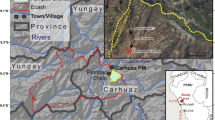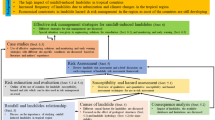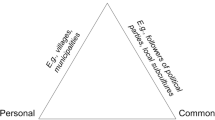Abstract
Despite the recognition of the need for mitigation approaches to landslide risk in developing countries, the delivery of ‘on-the-ground’ measures is rarely undertaken. With respect to other ‘natural’ hazards, it is widely reported that mitigation can pay. However, the lack of such an evidence base in relation to landslides in developing countries hinders advocacy amongst decision makers for expenditure on ex-ante measures. This research addresses these limitations directly by developing and applying an integrated risk assessment and cost–benefit analysis of physical landslide mitigation measures implemented in an unplanned community in the Eastern Caribbean. In order to quantify the level of landslide risk reduction achieved, landslide hazard and vulnerability were modelled (before and after the intervention), and project costs, direct and indirect benefits were monetised. It is shown that the probability of landslide occurrence has been substantially reduced by implementing surface-water drainage measures and that the benefits of the project outweigh the costs by a ratio of 2.7–1. This paper adds to the evidence base that ‘mitigation pays’ with respect to landslide risk in the most vulnerable communities—thus strengthening the argument for ex-ante measures. This integrated project evaluation methodology should be suitable for adoption as part of the community-based landslide mitigation project cycle, and it is hoped that this resource, and the results of this study, will stimulate further such programmes.








Similar content being viewed by others
Notes
Based on St Lucian government data for 2003, available at http://www.stats.gov.lc/wagavg.htm. This is a firm-level survey which asks employers to report the minimum, average and maximum wage paid to workers of each occupation type. We use the average maximum as an upper bound on wages.
The survey questionnaire is available from the authors on request.
Based on St Lucian government data for 2003, available at http://www.stats.gov.lc/wagavg.htm and http://www.stats.gov.lc/main3.htm. We use the average minimum as a lower bound on the wage rate.
“Discussion”.
References
AGS (2000) Landslide risk management concepts and guidelines. Aust Geomech Soc 35:49–92
Anderson MG (1990) A feasibility study on mathematical modelling of slope hydrology and stability. Final report on agreement CE 23/90. Geotechnical Control Office, Hong Kong
Anderson MG, Richards KS (1987) Modelling slope stability: the complementary nature of geotechnical and geomorphological approaches. In: Anderson MG, Richards KS (eds) Slope stability: geotechnical engineering and geomorpholology. Wiley, New York, pp 1–9
Anderson MG, Collison AJC, Hartshorne J, Lloyd DM, Park A (1996) Developments in slope hydrology-stability modelling for tropical slopes. In: Anderson MG, Brooks SM (eds) Advances in hill slope processes. Wiley, Chichester, pp 799–821
Anderson MG, Holcombe EA, Flory R, Renaud JP (2008) Implementing low-cost landslide risk reduction: a pilot study in unplanned housing areas of the Caribbean. Nat Hazards 47:297–315
Anderson MG, Holcombe E, Esquivel M, Toro J, Ghesquiere F (2010) The efficacy of a programme of landslide risk reduction in areas of unplanned housing in the Eastern Caribbean. Environ Manage 45(4):807–821
Annan KA (1999) Facing the humanitarian challenge: towards a culture of prevention. United Nations Department of Public Information, New York. DPI/2070
Anthony KD (2001) Strengthening, modernising and repositioning the economy. Budget speech by the Honourable Dr Kenny D. Anthony, Prime Minister and Minister for Finance, Economic Affairs and Information, Government of Saint Lucia
Belli P, Anderson J, Barnum H, Dixon J, Tan J-P (1998) Handbook on economic analysis of investment operations. World Bank
Benson C, Twigg J (2004) ‘Measuring Mitigation’ Methodologies for assessing natural hazard risks and the net benefits of mitigation–a scoping study. ProVention Consortium
Benson C, Twigg J, Rossetto T (2007) Tools for mainstreaming disaster risk reduction: guidance notes for development organisations. International Federation of Red Cross and Red Crescent Societies/the ProVention Consortium
Bishop AW (1955) The use of the slip circle in the stability analysis of slopes. Geotechnique 5(1):7–77
Blaikie P, Cannon T, Davis I, Wisner B (1994) At risk: natural hazards, people’s vulnerability, and disaster. Routledge, London
Blöchl A, Braun B (2005) Economic assessment of landslide risks in the Swabian Alb, Germany–research framework and first results of homeowner and expert surveys. Nat Hazards Earth Syst Sci 5:389–396
Board on Natural Disasters (1999) Mitigation emerges as major strategy for reducing losses caused by natural disaster. Science 284:1943–1947
Boardman A, Greenberg D, Vining A, Weimer A (2010) Cost-benefit analysis–concepts and practice. Pearson
Bonnin GM, Martin D, Lin B, Parzybok T, Yekta M, Riley D (2006) NOAA Atlas 14: precipitation-frequency atlas of the United States. Volume 3 Version 4.0: Puerto Rico and the U.S. Virgin Islands. U.S. Department of Commerce, National Oceanic and Atmospheric Administration, National Weather Service. Silver Spring, Maryland
Bründl M, Romang HE, Bischof N, Rheinberger CM (2009) The risk concept and its application in natural hazard risk management in Switzerland. Nat Hazards Earth Syst Sci 9:801–813
Bull-Kamanga L, Diagne K, Lavell A, Leon E, Lerise F, MacGregor H, Maskrey A, Meshack M, Pelling M, Reid H, Satterthwaite D, Songsore J, Westgate K, Yitambe A (2003) From everyday hazards to disasters: the accumulation of risk in urban areas. Environ Urban 15(1):193–203
Caribbean Development Bank (2004) Sourcebook on the integration of natural hazards into the environmental impact assessment (EIA) process. NIHA-EIA sourcebook, pp 217
Charveriat C (2000) Natural disasters in latin America and the caribbean: an overview of risk. Inter-American Development Bank. Working Paper #434
Corominas J (1996) The angle of reach as a mobility index for small and large landslides. Can Geotech J 33(2):260–271
Cundall PA (2001) A discontinuous future for numerical modelling in geomechanics? Proc Inst Civil Eng Geotech Eng 149(1):41–47
Dai FC, Lee CF, Ngai YY (2002) Landslide risk assessment and management, an overview. Eng Geol 64(1):65–87
ECLAC (2003) Handbook for estimating the socio-economic and environmental effects of disasters. Economic Commission for Latin America and the Caribbean, LC/MEX/G.5, LC/L.1874
ECMC (2007) National report on housing and resettlement in St Lucia, prepared by Engineering Construction and Management Consulting Ltd for the Ministry of Physical Development Environment and Housing, Government of Saint Lucia. http://www.stlucia.gov.lc/docs/NationalReportOnHousingInStLucia.pdf
Finlay PJ, Mostyn GR, Fell R (1999) Landslide risk assessment: prediction of travel distance. Can Geotech J 36(3):556–562
Glade T, Crozier MJ (2005) A review of scale dependency in landslide hazard and risk analysis. In: Glade T, Anderson MG, Crozier M (eds) landslide hazard and risk. Wiley, Chichester, pp 75–138
GoSL (2003) Average wage rates and labour force indicators, Department of Statistics, Government of Saint Lucia. http://www.stats.gov.lc/wagavg.htm http://www.stats.gov.lc/main3.htm
GoSL (2004) Core welfare indicators questionnaire survey. A pilot study in Saint Lucia, Main Report. Department of Statistics, Government of Saint Lucia
GoSL (2008) Saint Lucia National Housing Policy. Ministry of Housing, Urban Renewal and Local Government, Government of Saint Lucia. http://www.stlucia.gov.lc/docs/NHRPolicy.pdf
Gwilliam K (2000) Transportation project appraisal at the World Bank. ECMT-OECD Seminar on Evaluation Methodologies for Infrastructure Investments and Urban Sprawl., Organised in collaboration with the French Ministere de l’Equipment, des Transports et du Logement, and the Direction Regionale de l’Equipment d’Ile de France (DREIF). Paris
Holcombe EA, Anderson MG (2009) Implementation of community-based landslide hazard mitigation measures: sustainable project scale-up. Sustainable Development, doi:10.1002/sd.409
Holcombe EA, Anderson MG (2010) Tackling landslide risk: helping land use policy to reflect unplanned housing realities in the Eastern Caribbean. Land Use Policy 27:798–800
IFRC (2002) World Disasters Report 2002. Geneva: international federation of red cross and red crescent societies
ITASCA (2000) FLAC, Fast Lagrangian analysis of continua, user’s guide. Itasca Consulting Group, Inc., Minneapolis, Minnesota
Karnawati D, Ibriam I, Anderson MG, Holcombe EA, Mummery GT, Wang Y, Renaud J-P (2005) Identifying slope stability controls in southern Java to provide community-based landslide warning information. In: Glade T, Anderson MG, Crozier M (eds) Landslide hazard and risk. Wiley, Chichester, pp 733–763
Klohn-Crippen (1995) Tropical storm Debbie. Final report on hydrology, for Roseau Dam & Ancillary Works. WASCO, St. Lucia, West Indies
Kong WK (2002) Risk assessment of slopes. Q J Eng Geol Hydrogeol 35:213–222
Li Z, Nadim F, Huang H, Uzielli M, Lacasse S (2010) Quantitative vulnerability estimation for scenario-based landslide hazards. Landslides (available online 29 January 2010), doi:10.1007/s10346-009-0190-3
Lumb P (1975) Slope failures in Hong Kong. Q J Eng Geol 8:31–65
Mechler R (2005) Cost-benefit analysis of natural disaster risk management in developing countries: Manual. Bonn: Deutsche Gesellschaft fuer Technische Zusammenarbeit (GTZ) GmbH
Mechler R (2008) From risk to resilience. The cost-benefit analysis methodology. From risk to resilience Working paper no. 1. In: Moench M, Caspari E, Pokhrel A (eds) ISET, ISET-Nepal and ProVention, Kathmandu, Nepal, Provention Consortium, Geneva
Moench M, Mechler R, Stapleton S (2007) Guidance note on the costs and benefits of disaster risk reduction. Prepared for ISDR Global Platform on Disaster Risk Reduction High level dialogue, June 4–7, 2007
National Research Council (2004) Partnerships for reducing landslide risk: assessment of the National Landslide Hazards Mitigation Strategy. Committee on the Review of the National Landslide Hazards Mitigation Strategy, National Research Council. The National Academies Press, Washington
Opadeyi S, Ali S, Chin F (2005) Status of hazard maps, vulnerability assessments and digital maps in the Caribbean. Caribbean Disaster Emergency Response Agency (CDERA), Final report, 58 pp
Papathoma-Köhle M, Neuhäuser B, Ratzinger K, Wenzel H, Dominey-Howes D (2007) Elements at risk as a framework for assessing the vulnerability of communities to landslides. Nat Hazards Earth Syst Sci 7:765–779
Penning-Rowsell E, Johnson C, Tunstall S, Tapsell S, Morris J, Chatterton J, Green C (2005) The benefits of flood and coastal risk management: a manual of assessment techniques. Flood Hazard Research Centre. Middlesex University Press, London
Rasmussen TN (2004) Macroeconomic implications of Natural Disasters in the Caribbean. International Monetary Fund Working Paper WP/04/224
Rubio E, Hall JW, Anderson MG (2004) Uncertainty analysis in a slope hydrology and stability model using statistical and imprecise information. Comput Geotech 31(7):529–536
UN (2006) Landslides. Asia has the most; Americas, the deadliest; Europe the costliest; Experts seek ways to mitigatie landslide losses; Danger said growing due to climate change, other causes. United Nations University, news release January 18 2006, MR/E01/06/rev1
UNDP (2004) A global report. Reducing disaster risk: a challenge for development. Bureau for Crisis prevention and relief, United Nations Development Program
USGS (2003) National landside hazards mitigation strategy–a framework for loss reduction. US Geological Survey and US Department of the Interior
van Westen CJ, van Asch TWJ, Soeters R (2006) Landslide hazard and risk zonation–why is it still so difficult? Bull Eng Geol Environ 65:167–184
van Westen CJ, Castellanos E, Kuriakose SL (2008) Spatial data for landslide susceptibility, hazard and vulnerability assessment: An overview. Eng Geol 102:112–131
Vaunat J, Leroueil S (2002) Analysis of post-failure slope movements within the framework of hazard and risk analysis. Nat Hazards 26(1):83–109
Wamsler C (2006) Mainstreaming risk reduction in urban planning and housing: a challenge for international aid organizations. Disaster 30:151–177
Wilkinson PL, Brooks SM, Anderson MG (1998) Investigating the effects of moisture extraction by vegetation upon slope stability: further developments of a combined hydrology and stability model (CHASM). In: Proceedings of the British hydrological society international symposium on hydrology in a changing environment. Theme 4: Hydrology of Environmental Hazards, pp 165–178
Wilkinson PL, Brooks SM, Anderson MG (2000) Design and application of an automated non-circular slip surface search within a Combined Hydrology and Stability Model (CHASM). Hydrol Process 14:2003–2017
Wong HN, Ho KKS (1996) Travel distance of landslide debris. Proceedings of the seventh international symposium on landslides, Trondheim. AA Balkema, Rotterdam, pp 417–422
Wong HN, Ho KKS, Chan YC (1997) Assessment of consequences of landslides. In: Cruden D, Fell R (eds) Landslide risk assessment. Balkema, Rotterdam, pp 111–149
Zaitchik BF, van Es HM, Sullivan PA (2003) Variability and scale in the application of a physical slope stability model for landslide evaluation in Honduras. Soil Sci Soc Am J 67:268–278
Zêzere JL, Garcia RAC, Oliveira SC, Reis E (2007) Probabilistic landslide risk analysis considering direct costs in the area north of Lisbon (Portugal). Geomorphology 94:467–495
Author information
Authors and Affiliations
Corresponding author
Appendix: Deriving the present value of the expected costs of landslides of different types
Appendix: Deriving the present value of the expected costs of landslides of different types
1.1 Probabilities
Let:
-
p A,t = probability of a landslide of type A occurring in year t
-
p B,L,t = probability of a landslide of type B occurring in location L in year t
-
q A = 0.1
-
q B = 0.2
-
q A,I = 0.01 if intervention has occurred, 0.1 otherwise
-
q B,I = 0.02 if intervention has occurred, 0.2 otherwise
-
N = project lifetime
Assume:
That is, a landslide of type A may occur at most once—once it has occurred, the landscape is sufficiently altered that it may not occur again. The same goes for a landslide of type B: there are three locations in which this type of landslide may occur, and once it has occurred in a particular location, it may not occur in that location again. An additional restriction is that a landslide of type A affects the entire area in which landslides of type B may occur: once a landslide of type A has occurred, no landslide of type B may occur in any location. It is further assumed that if a landslide of type A occurs in a given year, no landslide of type B occurs that year.
Then prior probabilities are:
1.2 Present values
Let:
-
r = discount rate (constant)
-
δ t = discount factor for year t = 1/(1 + r) t
-
c A = Cost of a landslide of type A occurring
-
c B,L = Cost of a landslide of type B occurring in location L
-
PV A,y = Present value of expected costs from landslides of type A occurring in year y
-
PV B,L,y = PV of expected costs from landslides of type B occurring in location L in year y
Then:
And:
So the present value of expected costs from landslides of type A is:
which is a pair of geometric series, and so:
And the present value of expected costs from landslides of type B in location L is:
which is a pair of geometric series, and so:
Rights and permissions
About this article
Cite this article
Holcombe, E., Smith, S., Wright, E. et al. An integrated approach for evaluating the effectiveness of landslide risk reduction in unplanned communities in the Caribbean. Nat Hazards 61, 351–385 (2012). https://doi.org/10.1007/s11069-011-9920-7
Received:
Accepted:
Published:
Issue date:
DOI: https://doi.org/10.1007/s11069-011-9920-7




